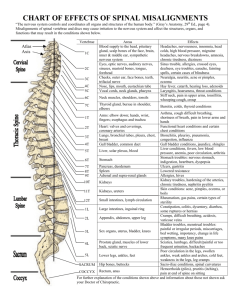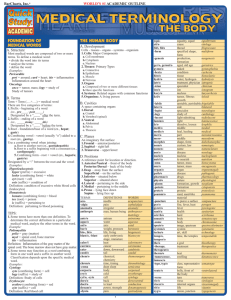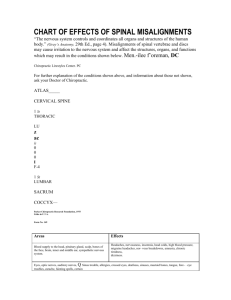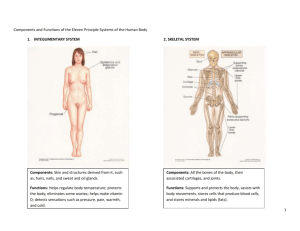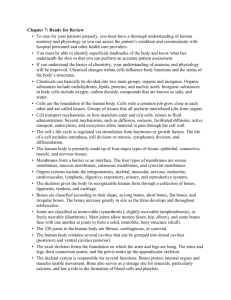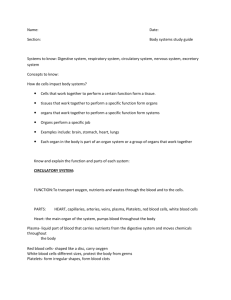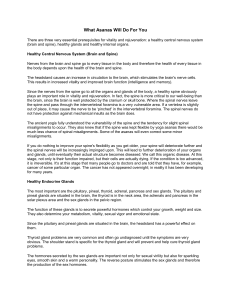ORGAN SYSTEMS REVIEW
advertisement
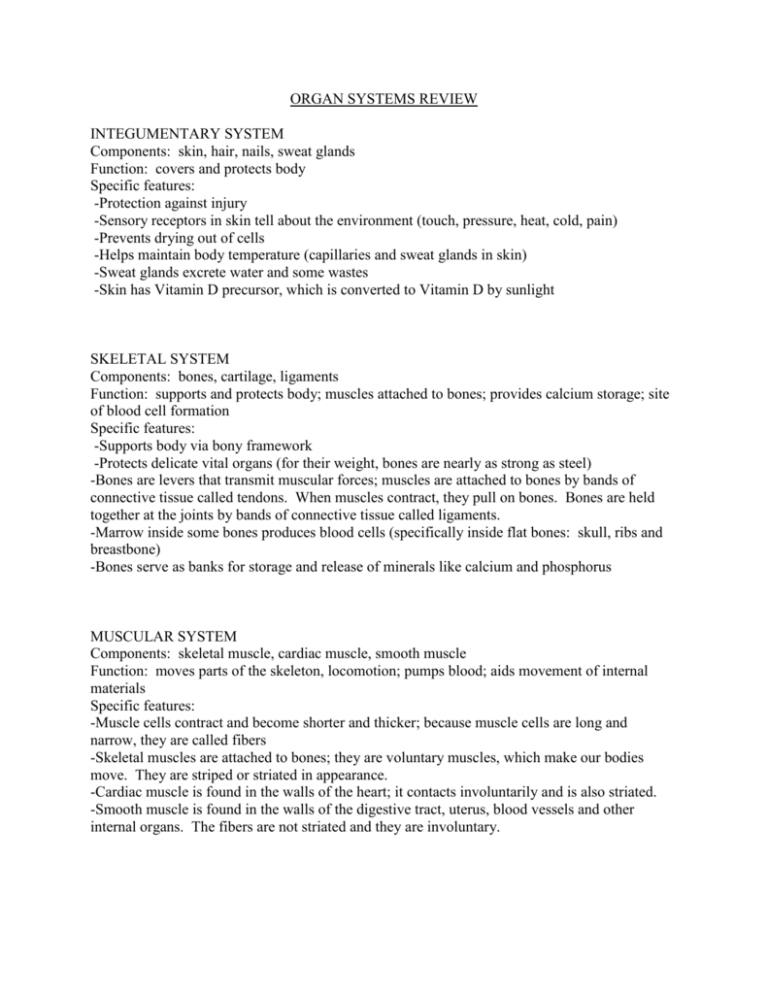
ORGAN SYSTEMS REVIEW INTEGUMENTARY SYSTEM Components: skin, hair, nails, sweat glands Function: covers and protects body Specific features: -Protection against injury -Sensory receptors in skin tell about the environment (touch, pressure, heat, cold, pain) -Prevents drying out of cells -Helps maintain body temperature (capillaries and sweat glands in skin) -Sweat glands excrete water and some wastes -Skin has Vitamin D precursor, which is converted to Vitamin D by sunlight SKELETAL SYSTEM Components: bones, cartilage, ligaments Function: supports and protects body; muscles attached to bones; provides calcium storage; site of blood cell formation Specific features: -Supports body via bony framework -Protects delicate vital organs (for their weight, bones are nearly as strong as steel) -Bones are levers that transmit muscular forces; muscles are attached to bones by bands of connective tissue called tendons. When muscles contract, they pull on bones. Bones are held together at the joints by bands of connective tissue called ligaments. -Marrow inside some bones produces blood cells (specifically inside flat bones: skull, ribs and breastbone) -Bones serve as banks for storage and release of minerals like calcium and phosphorus MUSCULAR SYSTEM Components: skeletal muscle, cardiac muscle, smooth muscle Function: moves parts of the skeleton, locomotion; pumps blood; aids movement of internal materials Specific features: -Muscle cells contract and become shorter and thicker; because muscle cells are long and narrow, they are called fibers -Skeletal muscles are attached to bones; they are voluntary muscles, which make our bodies move. They are striped or striated in appearance. -Cardiac muscle is found in the walls of the heart; it contacts involuntarily and is also striated. -Smooth muscle is found in the walls of the digestive tract, uterus, blood vessels and other internal organs. The fibers are not striated and they are involuntary. NERVOUS SYSTEM Components: nerves and sense organs, brain and spinal cord Function: receives stimuli from external and internal environments, conducts impulses and integrates activities of other systems Specific features: -Two divisions of the nervous system: central and peripheral -Central nervous system consists of the brain and spinal cord -Peripheral nervous system consists of the sense organs (eyes, ears, taste buds, olfactory receptors, touch receptors) and the nerves which connect the spinal cord with the rest of the body. These nerves are classified as either afferent (transmit information from the periphery to the spinal cord) or efferent (transmit information from the spinal cord to the periphery). -Peripheral nervous system is subdivided into two divisions: somatic division (consists of receptors and nerves concerned with changes in the outside environment; the sense organs and afferent nerves) and the autonomic division (regulates the internal environment; primarily the sympathetic and parasympathetic systems of the efferent system of nerves). ENDOCRINE SYSTEM Components: pituitary gland, adrenal gland, thyroid gland, hypothalamus gland, pineal gland, kidney, pancreas, ovaries, testes and other ductless glands (which are defined as tissues that secrete hormones that diffuse into the blood vessels) Function: regulates body chemistry and many body functions Specific features: -These glands are regulated by feedback control: information about hormone levels or their effect is fed back to the gland to regulate the hormone's release -Endocrine activity is controlled by the hypothalamus gland (which is located in the brain). This gland links the nervous and endocrine systems. As a result of nervous stimuli, it secretes several releasing and inhibiting hormones that affect the activity of the other glands. CIRCULATORY SYSTEM Components: heart, blood vessels, blood; lymph and lymph structures Function: transports materials from one part of the body to another; defends body against disease Specific features: -Consists of two subsystems: the cardiovascular system (includes the heart which pumps the blood through the blood vessels) and the lymphatic system (which helps to preserve fluid balance and protects the body against disease) -Transports nutrients from the digestive system to all parts of the body -Transports oxygen from the lungs to all the cells of the body -Transports carbon dioxide and other metabolic wastes from the cells to the excretory organs -Transports hormones from the endocrine glands to the target tissues -Helps maintain normal body temperature -Helps maintain fluid balance -Protects the body against disease-causing organisms. The lymphocytes, which are a type of white blood cell, are formed in the lymph tissue: lymph glands, spleen, thymus, tonsils and lymphoid tissue in the gut. There are two types of lymphocytes: T lymphocytes (the mediators of cellular immunity; these cells destroy the invader) and B lymphocytes (the antibody-producing cells; humoral immunity). RESPIRATORY SYSTEM Components: lungs and air passageways Function: exchanges gases between the blood and the external environment Specific features: -Respiration includes breathing, gas exchange between lungs and blood, transport of gases through the body by the blood, gas exchange between the blood and the cells and cellular respiration (the chemical reaction pathways by which chemical energy is obtained from food). DIGESTIVE SYSTEM Components: mouth, esophagus, stomach, intestines, liver, pancreas Function: ingests and digests foods, absorbs them into the blood Specific features: -Salivary glands, liver and pancreas are not part of the digestive system but secrete digestive juices into it -The digestive system involves four major processes: 1. Ingestion-taking food into the mouth, chewing and swallowing 2. Digestion-breakdown of food into smaller pieces (catalyzed by enzymes) 3. Absorption-transfer of digested food through the wall of the intestine and into the circulatory system 4. Elimination-removal of undigested and unabsorbed food from the body (in feces) URINARY SYSTEM Components: kidney, bladder and associated ducts Function: excretes metabolic wastes; removes substances present in excess from the blood Specific features: -Urine is made by the kidneys; it's transported from the kidneys to the bladder by the ureters; the bladder stores the urine then the urine leaves the bladder and exits the body via the urethra. -95% of urine is water. Also present is urea, which is produced in the liver (urea is the excretion form of nitrogen waste). EXCRETORY SYSTEM Components: large intestine and anus, skin Function: excretes solid metabolic wastes and wastes not removed by the urinary system REPRODUCTIVE SYSTEM Components: testes, ovaries and associated structures Function: reproduction, which provides for continuation of the species

